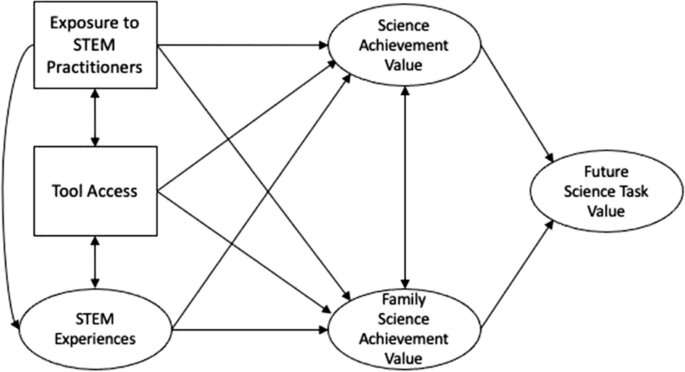This article has been reviewed according to Science X's editorial process and policies. Editors have highlighted the following attributes while ensuring the content's credibility:
fact-checked
trusted source
proofread
It takes a village: Study shows community is key to a sustained passion for science among adolescents

The results of a yearlong science program show that one of the best ways to instill a lasting interest in science among children is to engage them alongside their family members. This finding runs counter to the current framework, in which children attend science-related summer camps and after-school programs apart from their families, diminishing the long-term potential of what they learn.
"We wanted to see if we could support families as a whole, as opposed to giving a student a really amazing one-off experience and sending them home to parents who potentially aren't familiar with the content or don't know how to help them pursue classes they could take on the subject," said lead author Megan Ennes, assistant curator of museum education at the Florida Museum of Natural History.
In partnership with North Carolina State University, the authors based their study on a family science program hosted at three museums. Over the course of 10 months, families met on weekends for science-themed events, beginning each day with a communal meal.
Afterward, the cohort participated in hands-on activities and attended an information session led by professionals with careers in science, technology, engineering or mathematics (STEM), giving families first-hand accounts of what it's like to work in those fields. A local teen coding club demonstrated the nuances of programming by having families construct a Rube Goldberg machine in one session, and an astronaut visited to discuss the promise and perils of space travel in another.
During an event with a focus on local wildlife, an ornithologist helped families capture birds with mist nets, banding individuals that hadn't been caught before to monitor their populations. These formative activities were strengthened by shared experience.
"After the bird banding, one of the parents bought a feeder so they could continue talking about birds at home," Ennes said. "Our goal wasn't to convince students to become scientists, because not everyone wants that. But if we can help families see science as something they do for fun together, then we can help ensure they have a lifelong engagement with it."
The museums intentionally recruited families from low socioeconomic backgrounds, including groups that have been historically underrepresented in STEM careers. According to a 2018 report by the Pew Research Center, 11% of jobs in the U.S. are held by African Americans, compared with only 9% in STEM.
The gap is even wider among Hispanics and Asians, who respectively make up 16% and 17% of the workforce but hold only 7% and 10% of STEM jobs.
The authors also focused the program's content and activities toward elementary school students, who are often more perceptive of the natural world around them than their older peers.
"Most kids have an innate interest in science," Ennes said. "For them, it's about curiosity and wonder, but research shows that as they make their way through middle school, there's a significant decline in who remains interested and chooses to take optional science classes in high school. So we wanted to focus on upper elementary school, where children still have that curiosity, so that we could build a support system around it."
Children who participated in the program were more likely to envision themselves as scientists in the future than the students in the control group, who attended regular after-school programs during the same time period. Program participants also increasingly saw science as something they'd continue to use and engage with in the future, compared with children in the control group, whose perception of the importance of science waned throughout the year.
And despite the focus on younger students, the programs benefits also extended to other family members. Through exit surveys and personal correspondence, the authors noted that families began visiting other museums in their free time, and the program sparked or renewed an interest in science in siblings and parents.
"By designing programs for the family we are able to build in extended support for STEM interests," said study co-author Gail Jones, alumni distinguished graduate professor of science education at North Carolina State University. "Our families reported changing holiday gifts to include more gifts that build STEM interests; they reported spending more time exploring science together at home; and they sought out new experiences for STEM in their community."
One parent told Ennes that their seventh-grade student had failed their science classes through most of their schooling. After engaging in science activities with their family for a year, the student not only brought their grade up to an A but received an award for academic achievement from their school as well. A sibling from another family applied to become a museum volunteer, and three parents made the decision to go back to school and potentially obtain a degree in science.
Scientists are often portrayed as lone mavericks who make ground-breaking discoveries, but according to Ennes, engaging as a community is much closer to how scientists actually operate.
"Some of the greatest challenges and opportunities our society is faced with will be solved by teams rather than by individuals," she said. "Helping families see science as something they do together with a community can help build 21st-century skills needed to be successful in science and society, such as collaboration and flexibility. It also builds a supportive network to allow youth and families to explore new careers and lifelong hobbies related to science."
The paper is published in the journal Research in Science Education.
More information: Megan Ennes et al, Family Science Experiences' Influence on Youths' Achievement Value, Perceived Family Value, and Future Value of Science, Research in Science Education (2023). DOI: 10.1007/s11165-023-10116-7
Provided by Florida Museum of Natural History




















